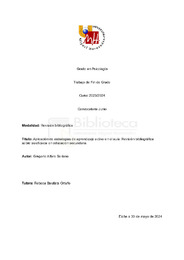Por favor, use este identificador para citar o enlazar este ítem:
https://hdl.handle.net/11000/32558Registro completo de metadatos
| Campo DC | Valor | Lengua/Idioma |
|---|---|---|
| dc.contributor.advisor | Bautista Ortuño, Rebeca | - |
| dc.contributor.author | Alfaro Soriano, Gregorio | - |
| dc.contributor.other | Departamentos de la UMH::Psicología de la Salud | es_ES |
| dc.date.accessioned | 2024-07-18T12:13:59Z | - |
| dc.date.available | 2024-07-18T12:13:59Z | - |
| dc.date.created | 2024-06 | - |
| dc.identifier.uri | https://hdl.handle.net/11000/32558 | - |
| dc.description.abstract | El aprendizaje activo es un tipo de enseñanza en la cual el estudiante es el gran protagonista, teniendo un papel dinámico durante el proceso de formación por el que el alumnado puede verse beneficiado de su utilización en los centros educativos. No obstante, actualmente en la mayoría de los centros educativos se utiliza un método más tradicional, en este el profesor suministra la información directamente al estudiantado, dedicándose estos solamente a escuchar, por lo tanto, teniendo un papel más pasivo. A pesar de la escasa aplicación en la educación, varias investigaciones creen que los beneficios del aprendizaje activo en los estudiantes son elevados. Por tanto, el objetivo de esta investigación fue revisar los estudios en los que se haya aplicado algún tipo de enseñanza dinámica en alumnos de educación secundaria, y que, posteriormente, se analizasen sus ventajas y desventajas y se comparasen con la tradicional. Los resultados reflejaron la gran cantidad de beneficios que el aprendizaje activo aporta al alumnado, mucho de los cuales no son obtenidos mediante el método tradicional. Sin embargo, también mostraron las dificultades que esta disciplina dinámica presenta a la hora de ser aplicado, suponiendo un reto para los docentes. | es_ES |
| dc.description.abstract | Active learning is a type of teaching in which the student is the main character, playing a dynamic role during the learning process, whereby students can benefit from its use in schools. However, at present, in most schools a more traditional method is used, in which the teacher provides information directly to the students, who only listen to them, in other words, playing a more passive role. Despite the limited application in education, several researches believe that the benefits of active learning for students are high. Therefore, the aim of this research was to review studies in which some form of active learning has been applied to secondary school students, and then to analyse its advantages and disadvantages and compare them with traditional learning. The results showed the many benefits that active learning brings to students, many of which are not obtained during the traditional method. However, they also showed the difficulties that this active method presents when it is applied, posing a challenge for teachers. | es_ES |
| dc.format | application/pdf | es_ES |
| dc.format.extent | 23 | es_ES |
| dc.language.iso | spa | es_ES |
| dc.publisher | Universidad Miguel Hernández de Elche | es_ES |
| dc.rights | info:eu-repo/semantics/openAccess | es_ES |
| dc.rights.uri | http://creativecommons.org/licenses/by-nc-nd/4.0/ | * |
| dc.subject | aprendizaje activo | es_ES |
| dc.subject | estudiantes | es_ES |
| dc.subject | educación secundaria | es_ES |
| dc.subject | educación | es_ES |
| dc.subject | active learning | es_ES |
| dc.subject | students | es_ES |
| dc.subject | secondary school | es_ES |
| dc.subject | education | es_ES |
| dc.subject.other | CDU::1 - Filosofía y psicología::159.9 - Psicología | es_ES |
| dc.title | Aplicación de estrategias de aprendizaje activo en el aula. Revisión bibliográfica sobre su eficacia en educación secundaria | es_ES |
| dc.type | info:eu-repo/semantics/bachelorThesis | es_ES |

Ver/Abrir:
TFG FINAL.pdf
719,93 kB
Adobe PDF
Compartir:
 La licencia se describe como: Atribución-NonComercial-NoDerivada 4.0 Internacional.
La licencia se describe como: Atribución-NonComercial-NoDerivada 4.0 Internacional.
Herramientas de Administrador
.png)